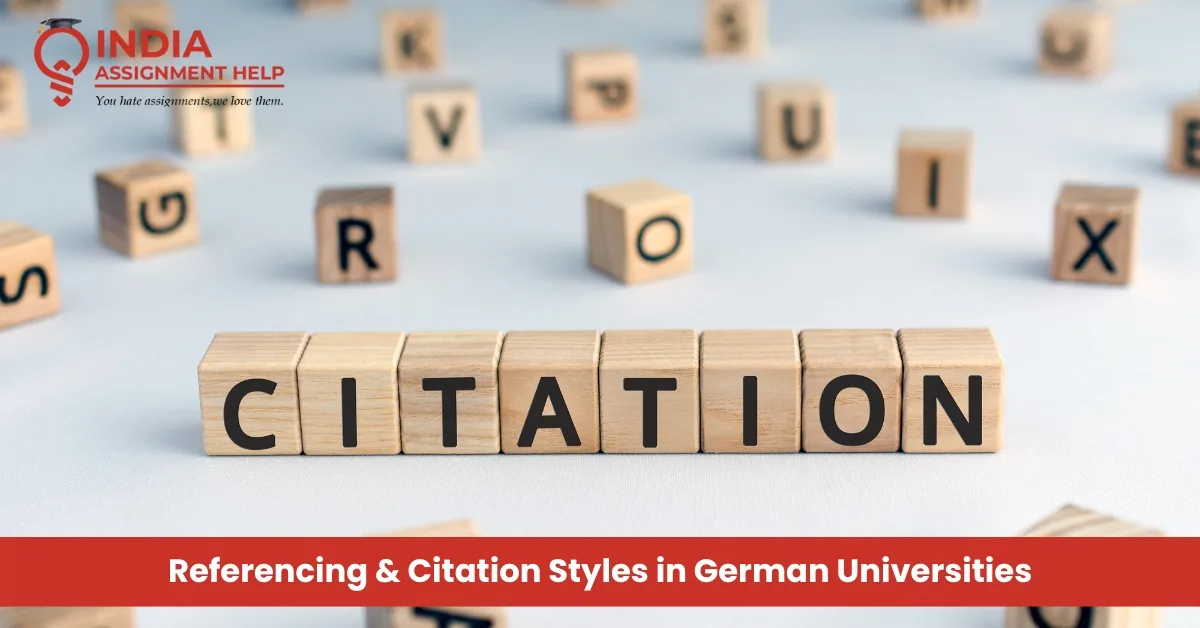A Guide to Referencing and Citation Styles in German Universities

When students write essays, research papers, or a dissertation, one of the most important aspects is how they give credit to sources. Proper citation styles are not just about avoiding plagiarism; they also make your work look more professional and trustworthy. In German universities, students often face strict academic rules about referencing, and learning the right style can be challenging, especially for international students. This blog explains why citations are important, introduces the most common styles, and gives you easy examples and tools that can make referencing much simpler.
Why Citation Matters in Academic Writing
In academic writing, every idea, argument, or data that comes from another author must be acknowledged. This process is known as referencing or citation. By following correct citation styles, students show that their work is based on reliable research and not copied.
German universities are very serious about academic integrity. A student who submits a paper without proper referencing may lose marks or even fail the assignment. Using correct styles is also a way of respecting the intellectual property of authors and researchers.
Moreover, citations guide readers to the sources, so they can explore the subject further. For instance, if you mention a theory in psychology, your citation allows your professor to find the exact book or article you used. This transparency builds your credibility as a writer.
For international students, learning about the citation style Germany follows is a big part of adjusting to academic life. Some institutions provide a referencing guide that universities follow internally, but students often need extra support. That is where professional services such as India Assignment Help become useful.
Overview of Popular Citation Styles
There are many citation styles, but only a few are widely accepted in German universities. Let’s look at the most common ones:
1. APA Style
The American Psychological Association (APA) style is popular in psychology, education, and social sciences. It emphasizes the date of publication, which makes it easy to see how recent a source is. An in-text citation looks like this:
(Miller, 2020, p. 15)
The reference list includes full details, for example:
Miller, J. (2020). Learning psychology. New York: Academic Press.
2. Harvard Referencing
The Harvard system is very popular in German business schools and many humanities programs. It is similar to APA but slightly more flexible. In-text citations look like this:
(Taylor 2019, p. 34)
The reference list might include:
Taylor, S. (2019). Business strategies in Europe. London: Routledge.
When students compare APA vs Harvard referencing, the main difference is formatting. APA uses commas between elements, while Harvard usually uses spaces and colons.
3. MLA Style
The Modern Language Association (MLA) style is often used in literature, languages, and cultural studies. Instead of dates, MLA highlights the author and page number. For example:
(Anderson 45)
The reference list (called “Works Cited”) looks like this:
Anderson, Mark. Modern Poetry in Europe. Oxford University Press, 2018.
4. Chicago Style
The Chicago style is common in history and the arts. It has two systems: notes and bibliography, or author-date. With notes and bibliography, you add footnotes at the bottom of each page. For example:
- John Smith, History of Europe (Berlin: Springer, 2021), 55.
In the bibliography:
Smith, John. History of Europe. Berlin: Springer, 2021.
Each of these citation styles has strict formatting rules, and students must follow the guide given by their university.
Faculty-Specific Preferences in Germany
Different faculties in Germany prefer different citation styles.
- STEM subjects (Science, Technology, Engineering, Mathematics) often use APA or IEEE. These fields value precision, so date and numerical references are important.
- Humanities such as history, philosophy, and literature prefer Chicago or MLA. These styles allow for detailed footnotes and explanations.
- Business and Social Sciences usually prefer Harvard or APA.
For an international student, this can be confusing. Some universities even have their own referencing guide universities provide, which mixes rules from different systems. For example, one German university may ask for Harvard style but with German punctuation.
This is why many students look for Academic Writing Help where experts are familiar with both local and international requirements.
Using Reference Managers
Manually creating citations can be very time-consuming, especially for a citation for a dissertation, which may have hundreds of references. Reference management tools can save hours of work.
- Zotero: A free tool that allows you to collect and organize research sources. It can generate references in different styles with one click.
- EndNote: A paid tool often used by researchers. It allows advanced organization of references and integrates with Microsoft Word.
- Citavi: Popular in Germany, Citavi offers features in both English and German. It is particularly useful for students in German universities because it connects with German library databases.
By using these tools, students can avoid mistakes in formatting and keep all their references in one place. However, it is still important to double-check, since no software is 100% accurate with every citation style.
Quick Examples of Correct In-Text Citations
To make things easier, here are short examples of in-text citations in different styles:
- APA: (Kumar, 2022, p. 12)
- Harvard: (Kumar 2022, p. 12)
- MLA: (Kumar 12)
- Chicago (author-date): (Kumar 2022, 12)
- Chicago (footnote): 1. Surya Kumar, Education in Germany (Munich: Springer, 2022), 12.
For a citation for a dissertation, universities expect perfect consistency. Even small errors, such as a missing comma, can reduce grades.
Challenges for International Students in Germany
International students often struggle with:
- Understanding the different citation styles in Germany
- Translating referencing rules from English to the German academic system.
- Choosing between APA vs Harvard referencing when both are accepted.
- Creating a citation for a dissertation with hundreds of references.
Language barriers can also make it harder to read the referencing guide that universities provide, especially if it is only in German. For these reasons, many students rely on Citation Help and Referencing Help services for guidance.
How India Assignment Help Supports Students
At India Assignment Help, students in Germany can get expert assistance with referencing and academic writing. The service offers:
- Citation Help: Correct formatting in any style required by the university.
- Referencing Help: Step-by-step guidance on how to create reference lists.
- Academic Writing Help: Full support for essays, research papers, and dissertations.
- Professional guidance for APA vs Harvard referencing, MLA, Chicago, and more.
- Specialized support for citations for dissertation projects.
By choosing professional help, students save time and ensure their work meets German academic standards.
Conclusion
Mastering citation styles is one of the most important skills for students in German universities. From APA and Harvard to MLA and Chicago, each system has its own rules, and knowing which one to use depends on your faculty. International students often face difficulties with citation styles Germany follows, but with the right referencing guide that universities provide, reference managers, and professional support, the process becomes much easier.
Whether you are comparing APA vs Harvard referencing, creating a citation for a dissertation, or just writing your first essay, accuracy in referencing is essential. Services like India Assignment Help provide reliable Citation Help and full Academic Writing Help, making sure students can focus on learning while still meeting strict academic standards.





